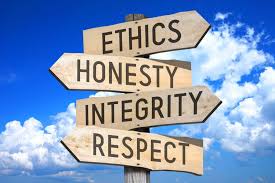Ethics and Culture Lessons from the NBA Finals

Matt Stankiewicz, Senior Counsel at The Volkov Law Group, rejoins us for a posting on compliance lessons from the NBA Finals. Matt can be reached at [email protected].
As a huge sports fan and compliance practitioner, I can’t seem to divorce the two when I’m watching a sporting event, for better or for worse. So while watching the National Basketball Association (“NBA”) Finals, one major event struck a chord with me and provided a good learning lesson on a difficult area for many in the compliance industry. Many organizations today, large and small, struggle with fostering a positive and compliant culture throughout their respective organizations. It’s something that the entire NBA does extremely well, and recent events offer a great learning point.
This year’s Finals featured a dramatic matchup between the Golden State Warriors and the Toronto Raptors. During Game 3, Kyle Lowry of the Raptors jumped into the stands to save a loose ball and landed upon the courtside seats. Lowry landed next to a fan who proceeded to shove him and yell expletives at him. Lowry, to his credit, handled himself professionally, did not retaliate, and instead returned to the court, albeit a bit flustered and upset. Shortly afterwards, Twitter began to buzz as it was revealed that the fan who shoved Lowry was actually Mark Stevens, a billionaire minority owner of the Golden State Warriors.

For those that are not sports nuts like myself, here is a background on league structure that will guide this discussion. The teams jointly run the league. The NBA entity itself is essentially a legal cartel that operates at the whims of the individual teams and their owners. While the league has a commissioner and its own corporate structure, all of those individuals effectively operate under the teams. Thus, the team owners are essentially the highest rank in the organization. The players on the other hand are unionized employees. Most of the major sports leagues operate in this manner.
Now where does the compliance lesson come in? As I discussed earlier, many organizations struggle with their internal culture for a variety of reasons. Establishing a strong and compliant corporate culture is paramount for an effective compliance program, as even the DOJ has harped on in its recent guidance. When we conduct compliance trainings with our clients, one item that we always address is that companies must ensure that discipline is consistently enforced across the organization. It should not matter if it’s the CEO, a member of the Board of Directors, or the top salesman in the company. If the company truly has a “zero tolerance” policy for a transgression, then “zero tolerance” only means “zero tolerance” if that holds for everyone.
So let’s circle back to the events of Game 3. Mr. Stevens laid hands on Lowry, a player on the opposing team, and followed up with some verbal abuse. This is a major taboo. Normal fans have been banned for life just for verbal harassment, never mind the physical type. Meanwhile, had the roles been reversed, Lowry would have received significant punishment. After the game, even the Warriors players stood up for Lowry, noting that he was helpless in that situation as any sort of retaliation would have at least ended his playing time in the Finals, and at worst, possibly even end his career. At this point, all eyes turned to NBA Commissioner Adam Silver. How would he handle this?

Now let’s look at the cultural ramifications at play here. To this end, we can contrast the NBA with the National Football League (“NFL”). The NFL has a significant cultural issue that unfortunately weighs heavily on everything the league does. Tensions between the owners and the players (the workforce) run extremely high and there is a clear schism between the two groups. At the epicenter is NFL Commissioner Roger Goodell. A key lynchpin of the poor culture stems from the perceived inconsistency in meting out discipline, especially as it pertains to the owners. Fair or not, there is a perception that the league is harder on its players. And simply the perception is all that’s needed to cause culture problems.
Let’s turn back to the situation in the NBA, now that we can see the consequences of failing to handle this situation properly. Here we have Commissioner Silver in a situation where he is forced to essentially discipline his boss. If he comes down too light, he risks a crippled culture and losing the support of his workforce. Come down too hard, and does he risk his own career?
To that end, Commissioner Silver, who I admire greatly, wasted no time in handing out a significant punishment in line with the actions at issue. Mr. Stevens was fined the maximum amount of $500,000, suspended from all team activities for an entire year, and will likely be forced to sell his shares in the Warriors.
The message was clear. It doesn’t matter who you are, our organization maintains a high standard of conduct, and those that fall below a certain threshold will be disciplined accordingly. Period, the end.
The lessons here can be applied to all organizations. The key here isn’t necessarily the severity of the punishment. Rather, the key is the consistent application of disciplinary measures, based upon the internal policies and procedures established by the organization or based upon historical enforcement. If your organization has a zero-tolerance policy on retaliation, for example, then substantiated claims of retaliation must be handled accordingly regardless of the perpetrator. Otherwise, the message the organization sends is that revenue, sales, or some other variable takes precedence over compliance. Subsequently, culture deteriorates quickly and will take exponentially longer to improve it in the future.

Again, culture can be a complicated issue for most organizations. We find that a majority of organizations may not actually have a grasp of the underlying culture permeating all levels of the organizations. We’ve found situations where key initiatives that were diligently designed by the Compliance function, end up completely ineffective at the line worker level due to cultural issues existing in the local business. As such, we recommend periodic surveys or, for maximum impact, focus groups conducted by independent observers to allow for an open and honest dialogue. The findings from these activities are often eye opening. Connect with us to discuss possible solutions for your specific needs.















